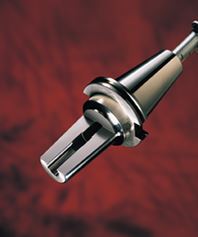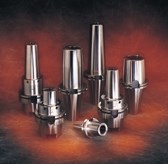Shrink Fit Expands Its Market
Shrink fit toolholders offer moldmakers a series of benefits, including better high-speed machining.
Although shrink fit has been around for many years, it is now beginning to make its way into mainstream manufacturing. With the introduction of less expensive induction machines, we are seeing shrink fit tooling not only in Fortune 500 manufacturing facilities, but also in shops with as few as five machining centers. In the past, the cost of the induction machines exceeded $30,000, which restricted the introduction of shrink fit into many shops. The reason for this is that they did not have the volume of toolholders necessary to allocate the cost of the machine to a reasonable amount per toolholder.
While endmill holders and collet chucks are the most predominant toolholders in the industry, they sometimes lack the accuracy or rigidity required for high-speed or high-precision machining. Conventional endmill holders sacrifice concentricity and provide two- or three-point clamping. The thin profile provided by shrink fit tooling enables the operations to be performed with less interference. Cutting tools can easily be preset by simply controlling the depth that the shank extends into the bore. Milling chucks - another popular toolholder - are suitable for rigid, precise machining; however, they are bulky and have larger nose diameters, which makes machining of cavities or deep pockets difficult. Hydraulic chucks are ideal for precise machining and finishing work, but lack the rigidity needed for aggressive machining applications associated with most moldmaking applications.
Counting Your Benefits
The benefits of shrink fit tooling are numerous. The first of these benefits is unparalleled, uniform gripping strength. The shrink fit toolholder's inside diameter is designed to be slightly smaller than the shank diameter of the cutting tool. When the shrink fit toolholder is placed into the induction heating system, the inside diameter of the clamping end is heated and expands. The tool shank can then slip easily into the holder. As the holder cools, the resulting thermal contraction exerts a tremendous, uniform pressure around the entire surface of the tool shank, exceeding the gripping strength of conventional toolholders by a minimum of five to seven times, depending on the shank tolerance of the cutting tool. This is not the case with milling chucks and hydraulic chucks. These chucks leave an area of up to 1/4 inch from the end of the toolholder with no force applied to the tool shank. Shrink fit tooling provides you the closest possible rigidity to an integral shank tool with lower costs and more flexibility. The rigidity established with shrink fit tooling enables cutting tool applications to be pushed to the maximum limits.
The second benefit of shrink fit tooling is superior concentricity. The maximum acceptable total indicated runout (TIR) is 0.0002" at four times the diameter of the cutting tool from the toolholder nose. The superior concentricity provides greater surface finish - minimizing or eliminating the hand polishing of molds and thereby reducing the total processing cost of the mold. It also increases the geometric accuracy of molds, which is critical when manufacturing unit molds. Another benefit of superior concentricity that should not be overlooked is the increase of cutting tool life and the associated decrease of cutting tool expenses. With the superior concentricity and balance, the chip load is evenly distributed on the cutting edge.
The third benefit of shrink fit tooling is its suitablility for high-speed machining. Moldmaking machines' spindle speeds currently exceed 40,000 rpm. In extreme high-speed operations, centrifugal force becomes an important factor in desired speeds and feed-rates. With the holding force generated by shrink fit tooling being superior, no other system can maintain the clamping force. It is a must in extreme high-speed applications and is superior at any speed.
A Balancing Act
A critical component in high-speed machining is the acceptable unbalance of the toolholder, cutting tool and retention stud assembly. The dominant balancing factor in many tooling assemblies is the toolholder, since its mass, in a majority of the cases, greatly exceeds that of the cutting tool and the retention stud. Some may therefore assume that loading any cutting tool into a balanced toolholder will result in a balanced assembly. But cutting tools and retention studs may have a relatively high degree of inherent unbalance. Even though its mass is comparatively less, an unbalanced cutter or retention stud, when loaded into a pre-balanced holder, will create a significant amount of unbalance, especially for high-speed machining, which is more sensitive to system unbalance.
Since shrink fit toolholders minimize the unbalanced portion of the toolholder by eliminating any moving parts, the only variable is the cutting tool. The unbalance of the cutting tool can be compensated by either removing metal or utilizing a balanceable toolholder. Some shrink fit toolholders utilize a balancing method that locates the balancing screws parallel to the center line, allowing balancing to be near perfect.
While balanceable shrink fit toolholders also are manufactured to a particular balance level up to a particular speed, they feature a system that allows for re-balancing. Through the use of a toolholder balancing system, these toolholders can be easily re-balanced, meeting the requirements of high-speed machining center manufacturers.
Shrink fit toolholders offer the useful benefits of superior gripping force, concentricity and accuracy, and offer excellent high-speed suitability. Now that the induction machines are more affordable, it is easy to see why shrink fit is becoming the toolholder of choice for moldmakers everywhere.
Related Content
Hands-on Workshop Teaches Mold Maintenance Process
Intensive workshop teaches the process of mold maintenance to help put an end to the firefighting culture of many toolrooms.
Read MoreMoldmakers Deserve a Total Production Solution
Stability, spindle speed and software are essential consideration for your moldmaking machine tool.
Read More6 Ways to Optimize High-Feed Milling
High-feed milling can significantly outweigh potential reliability challenges. Consider these six strategies in order to make high-feed milling successful for your business.
Read MoreRead Next
High-Speed Collet Toolholder Or Shrink-Fit Tooling
An in-depth look at the benefits of a quality high-speed collet toolholder reveals advantages over shrink-fit tooling for most high-speed applications.
Read MoreHow to Use Continuing Education to Remain Competitive in Moldmaking
Continued training helps moldmakers make tooling decisions and properly use the latest cutting tool to efficiently machine high-quality molds.
Read MoreAre You a Moldmaker Considering 3D Printing? Consider the 3D Printing Workshop at NPE2024
Presentations will cover 3D printing for mold tooling, material innovation, product development, bridge production and full-scale, high-volume additive manufacturing.
Read More.png;maxWidth=970;quality=90)











.png;maxWidth=300;quality=90)











